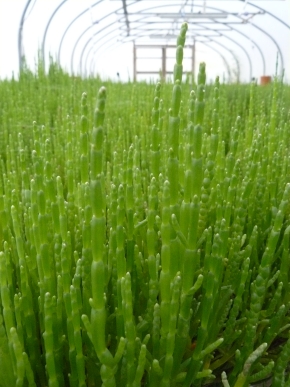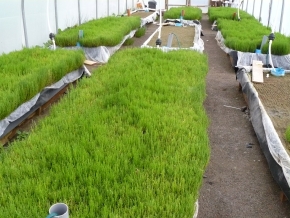Salicornia - Marsh Samphire
'Sea Vegetables'
Using the discharge water from our marine pilot systems (turbot and shrimp) - we have developed the technology to produce the highest quality Marsh Samphire - Salicornia - for human consumption. Also known as Sea Asparagus, test marketing of our Samphire since 2006 has proved the product a success with top restaurants and retailers.Using horticultural 'polytunnels' and specially designed culture beds we achieve an output of up to 10 kg per square metre per year and are the only UK producer.
Not only does the system provide a saleable, high quality product from the waste water stream, but has proved highly effective in removing excess nutrients thus reducing environmental impact.
Scientific Summary
In collaboration with University of Bangor - Wales. The project has developed techniques for propagation and production of high performing varieties of Salicornia europea in northern Europe in greenhouses, over a summer season from April-October. Results include selection of optimal variety based on growth performance, techniques for mass seed collection and germination, optimal nutrient (N,P) and salinity levels for growth, yield and product quality, in terms of protein and fatty acid content. In addition, simple and effective designs for constructed wetland biofilters have been developed, in which layers of gravel and sand are arranged to allow effective circulation of water through the roots. This system is designed for batch treatment of very nutrient-rich waste seawater discharged on a daily basis from backwashing of bio-filters in an intensive recirculation fish farm. During periods of low nitrogen flux, analysis of the inlet and outlet water samples showed clearly that within each 24hr flood period the wetlands removed almost 100% of the dissolved inorganic nitrogen in the waste water used to irrigate the beds. Although concentrations varied this was the case for all dissolved inorganic nitrogen (DIN) forms; ammonium, nitrate and nitrite; with a few exceptions for each DIN form, the constructed wetlands were 90 – 100% efficient at removing ammonium, nitrate and nitrite. Unlike DIN forms, phosphate showed a different pattern with percentage removal ranging between 36- 89%. Simulation of very high nitrogen flux was achieved by addition of an ammonium nitrate fertiliser to the inlet water,to determine maximum N removal capacity of the wetlands. When ammonium concentrations exceed 500 μMol/l the percentage of ammonium removed was dramatically reduced from 90-100% to 30% at the very highest ammonium levels. For nitrate the pattern was similar; when nitrate concentration exceeds 500 μMol/l the percentage of nitrate removed fluctuates between 25-50%. Phosphate removal remained in the range between 30-55%. These results indicate that the constructed wetlands could remove up to 0.2 moles N per m-2 d-1 at peak efficiency. Nitrogen and phosphate budgets show that under low flux conditions, nearly all N & P retained by the biofilter is taken up by the plants, while this drops to around at 40% in high flux conditions. Effective cropping regimes were developed for the contstructed wetlands, where plants were trimmed every 3 weeks, generating up to 4kg m-2 fresh weight yield of high quality food-grade product at each harvest.


